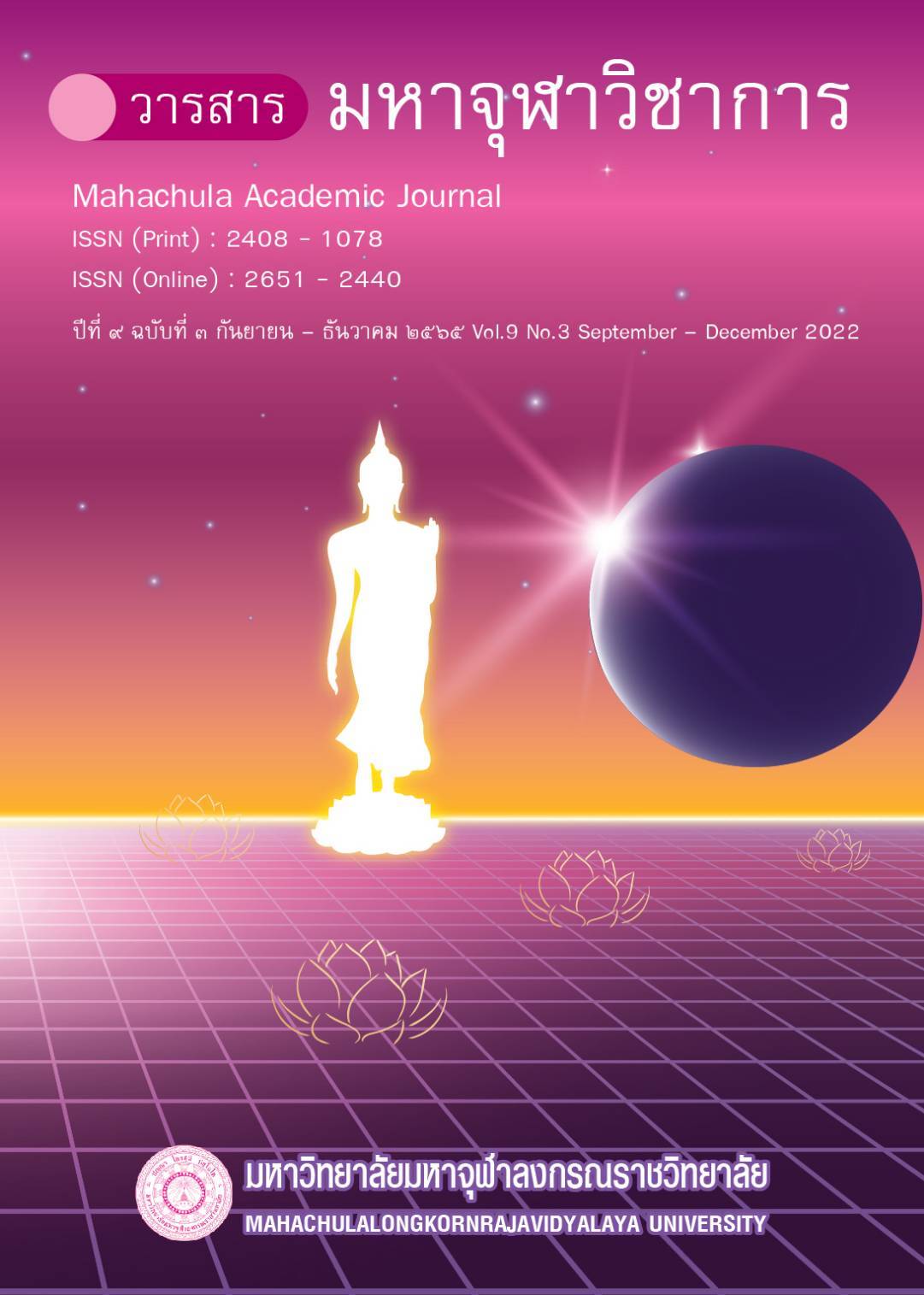A Comparative Study of The Nagas in Brahmanism-Hinduism and Theravada Buddhism
Main Article Content
Abstract
The thesis entitled consists of the following objectives: (1) to study Naga in Brahmanism-Hinduism; (2) to investigate Naga in Theravada Buddhism; and (3) to compare Naga in Brahmanism-Hinduism and Theravada Buddhism. The study employed qualitative research method by way of documentary research. The data were collected from the Tipitaka, commentaries, and the Purana literature, etc.
From the study, the following findings are found: In Brahmanism-Hinduism, the Naga, or serpentlike water-god, is a powerful semidivine being born from eggs. All Nagas are believed to be the offspring of the great Rishi Kashyapa and Kadru. Nagas have Garuda as their brother, who eventually become an enemy. They are shaped like a giant snake with crest, red eyes, and split tongue. Higher-class Nagas have golden skin, whereas those of lower class have black skin. Nagas have powerful venoms and poisons. They have heads from one to a thousand, and their length varies depending on their perfections. Nagas usually appear in deity form who are capable of bringing rain. Nagas inhabit in Kshira Sagara (the Ocean of Milk), Patala Loka (the underworld), Ramaniya (delightful island), Bhogavati (the subterranean capital). They have the duty to serve the three deities: Vishnu, Shiva, and Varuna. The belief in Nagas has influenced Thai society in terms of painting, sculpture, literature, culture, and tradition. In Theravada Buddhism, Nagas are powerful deity of the lower class. They are the followers of Virupaksa. They have four modes of generation: born from eggs (Andaja), from womb (Jalabuja), from moisture (Samsedaja), and of spontaneous birth (Opapatika). There are four principle Naga chiefs which are Virupaksa, Elapatra, Chabayaputta, and Kanhagotama. Nagas born spontaneously are superior to Nagas born from eggs, from the womb, and from moisture. Their fangs, eyes, mouth, nose, and body are poisonous. Nagas are enemy of Garuda, while Garuda cannot eat seven types of Nagas. Nagas inhabit in Mount Meru, the heaven realms, and the ocean. Their duty is to serve the Buddha, protect the nature and heaven realms. They have both the right view (sammaditthi) and wrong view (micchaditthi). They also have jewels and are ferocious. The belief in Nagas has influenced Thai society in terms of religion, history, culture, and tradition. Based on a comparative analysis, it reveals that they have both similarity and differences. They are similar in terms of shape, residence, toxicity, supernatural power, half-animal and half-deity, and enemy of Garuda. In terms of differences, they are as follows: in Brahmanism-Hinduism, Nagas are the offspring of deities, the brother of Garuda, immortal, with a thousand heads and jewels, and they receive divine blessings; while in Theravada Buddhism, Nagas are not the offspring of deities since they have four modes of generation, mortal, food of Garuda, with the duty of protecting nature, heaven realms, and religion. They are also the followers of Virupaksa, and neither have any divine blessings nor the vehicle for deities.
Article Details

This work is licensed under a Creative Commons Attribution-NonCommercial-NoDerivatives 4.0 International License.
References
ณัฐนารถ ปิ่นเฟื่อง. ตำนานพญานาคสองฝั่งโขง. กรุงเทพมหานคร: รุ่งศิลป์การพิมพ์, ๒๕๔๗.
ทศพล จังพานิชย์กุล. นาคเทพผู้ปกป้องพระพุทธศาสนา. กรุงเทพมหานคร: คอมม่าดีไซน์, ๒๕๕๔.
ผาสุก อินทราวุธ. ความเชื่อเกี่ยวกับนาคในอารยธรรมลุ่มน้ำสินธุ. กรุงเทพมหานคร: แสงศิลป์, ม.ป.ป.
พระมหาประภาส แก้วสวรรค์. “ศึกษานาคในพระไตรปิฎก”. วิทยานิพนธ์อักษรศาสตรมหาบัณฑิต. บัณฑิตวิทยาลัย: จุฬาลงกรณ์มหาวิทยาลัย, ๒๕๔๐.
พระราชภาวนาวิสุทธิ์ (ไชยบูลย์ ธมฺมชโย). พญานาค. กรุงเทพมหานคร: กัลยาณมิตร, ๒๕๔๗.
พระสมพร อนาลโย (จิตรกล้ำ). “การศึกษาพญานาคในชุมชนคำชะโนด”. วิทยานิพนธ์ปริญญาพุทธศาสตรมหาบัณฑิต สาขาวิชาพระพุทธศาสนา. บัณฑิตวิทยาลัย: มหาวิทยาลัยมหาจุฬาลงกรณราชวิทยาลัย, ๒๕๕๐.
พีรพล พิษณุพงศ์. ความสัมพันธ์ระหว่างงูกับมนุษย์. กรุงเทพมหานคร: แสงศิลป์การพิมพ์, ๒๕๑๐.
เมธาราช รัตนภาคี. ตำนานนาคจากพุทธกาลสู่ตำนานลุ่มน้ำโขง. นนทบุรี: อุทยานความรู้, ๒๕๑๑.
ราชบัณฑิตยสภา. พจนานุกรม ฉบับราชบัณฑิตยสถาน. กรุงเทพมหานคร: นานมีบุ๊คส์พับลิเคชั่นส์, ๒๕๕๔.
วิเชียร นามการ. “การศึกษาอิทธิพลความเชื่อของนาคที่มีผลต่อสังคมไทยยุคปัจจุบัน”. วิทยานิพนธ์พุทธศาสตรมหาบัณฑิต สาขาวิชาพระพุทธศาสนา. บัณฑิตวิทยาลัย: มหาวิทยาลัยมหาจุฬาลงกรณราชวิทยาลัย, ๒๕๕๕.
ศานติ ภักดีคำ. พระนารายณ์. กรุงเทพมหานคร: อมรินทร์, ๒๕๕๖.
ศานติ ภักดีคำ. นาค. กรุงเทพมหานคร: อมรินทร์, ๒๕๕๖.
สุจิตต์ วงษ์เทศ. นาคในประวัติศาสตร์อุษาคเนย์. กรุงเทพมหานคร: แสงศิลป์การพิมพ์, ๒๕๔๓.
สมเด็จพระเจ้าบรมวงศ์เธอ กรมพระยาดำรงราชานุภาพ. นาคที่ปรากฏในงานศิลปกรรม. กรุงเทพมหานคร: ม.ป.ท., ๒๕๐๓.
อรุณศักดิ์ กิ่งมณี. ตรีมูรติอภิมหาเทพของฮินดู. กรุงเทพมหานคร: เมืองโบราณ, ๒๕๕๑.


